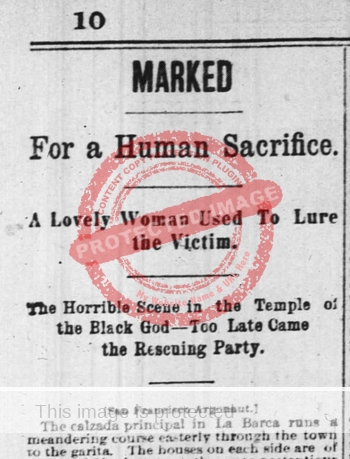Some years ago, I stumbled across an early, unattributed short story which mentioned Lake Chapala and made several references to the town of La Barca, and to José Velarde (“The Golden Ass”). The story, titled “The Sorceress” and published in 1894, was about the impacts of superstition, religion and sacrifice.

Warner’s “The Sorceress,” as printed in Cincinnati Enquirer, 1894.
Recently, while researching a short story by Gwendolen Overton, titled “The White Rebozo,” it occurred to me that she may also have written “The Sorceress.” However, after diving down several more rabbit holes, I now know that “The Sorceress” was the work of civil engineer Edwin Hall Warner (1858-1927), and that its original subtitle in The Argonaut was “How an American Engineer was Sacrificed to the Aztec Gods.”
Edwin Hall Warner, born in New York on 21 February 1858, studied civil engineering at the Polytechnic Engineering Department of the University of the City of New York. From about 1884 to 1888, he worked for the Mexican Central Railway (which includes the Mexico City-Irapuato-Ocotlán-Guadalajara line) and the Union Pacific Railway, before taking a position as an engineer of the Seattle, Lake Shore & Eastern Railway.
On 21 August 1890, Warner married Frances Beatrice Genevieve Ferguson in Seattle, Washington. Her family lived in Seattle, though she had been born on 10 August 1868 in Tepic, then in Jalisco, now in Nayarit. The couple had no children.
Shortly after marrying, Warner resigned from his position with the Seattle, Lake Shore & Eastern Railway, and announced plans to open an office with his brother, Joseph L Warner, for consultancy work in civil and mining engineering. The brothers were co-founders and shareholders of the Culver Gold Mining Company.
In May 1892, Warner initially declined an offer to be the Seattle city engineer, but he did briefly hold that position a couple of years later, before political infighting resulted in his removal.
Possibly soured by his experiences in Seattle, Warner began to publish short stories. Among those published in The Argonaut and similar high quality publications were “The Painted Statue” (1894); “Love in Mexico: An American Engineer’s Ride for Life that Followed a Fiesta” (1895); “The Torture of Doubt” (1895), about a poor Mexican flower-seller’s jealousy of a wealthy American lady; and “In a Mexican Plaza” (1895), which begins, “The state of Jalisco is the Andalusia of Mexico. Nearly in the centre lies Guadalajara, the garden city of….” In addition to his prose pieces, Warner published several poems in the Los Angeles Times, including “Only a Volunteer” (1917) and “The Spy” (1918).
In 1896, Warner gave specialist testimony, as a “civil engineer in Seattle” at the inquest into the Point Ellice Bridge disaster in Victoria, BC.
Alongside writing and private consultancy work, Warner worked several years at the turn of the century for the Republic Mining Company; his map of the City of Republic (c. 1899) is a collector’s item. Warner also worked as the principal assistant engineer for the Columbia Improvement Company at Electron, Washington.
Warner and his wife then moved to Venice, California, where he supervised engineering projects related to water, before being appointed chief engineer of the Tri-State Land Company in 1905.
In 1906, Warner returned to Mexico for a year as assistant chief engineer of the Necaxa Dam in Puebla for the Mexican Light and Power Company.
On his return to California, Warner settled in Los Angeles to design irrigation projects and piers, including the Santa Monica pier, “the first all-concrete self-supporting pleasure pier in the world.” He also undertook work for the Southern California Edison Company, and on early concrete dams, such as the Kerckhoff Dam and the Snow Mountain Dam.
In later life, Warner and his wife moved to Burlingame, California. Following his death on 17 June 1927, his obituary described him as “an Alaska pioneer” who had done “extensive work in Panama and Mexico.”
Lake Chapala: A Postcard History (2022) uses reproductions of more than 150 vintage postcards to tell the incredible story of how Lake Chapala first became an international tourist and retirement center.
Sources
- Willi H. Hager. 2015. Hydraulicians in the USA 1800-2000: A biographical dictionary of leaders in hydraulic engineering and fluid mechanics, Vol 2, 2687. CRC Press.
- Juneau Empire: 18 Jun 1927, 1.
- Los Angeles Herald, Volume XLI, Number 258, 28 August 1915.
- The Seattle Post-Intelligencer: 22 Aug 1890, 6; 30 Nov 1890, 3; 27 Sep 1891, 5; 23 Jan 1894, 8;
- The Victoria Daily Times: 9 Jun 1921, 4.
- Edwin Hall Warner. 1894. “The Sorceress : How an American Engineer was Sacrificed to the Aztec Gods.” The Argonaut (San Francisco), Vol. XXXV. No. 2 (July, 1894), 4.
Comments, corrections and additional material are welcome, whether via the comments feature or email.
Tony Burton’s books include “Lake Chapala: A Postcard History” (2022), “Foreign Footprints in Ajijic” (2022), “If Walls Could Talk: Chapala’s historic buildings and their former occupants” (2020), (available in translation as “Si Las Paredes Hablaran”), “Mexican Kaleidoscope” (2016), and “Lake Chapala Through the Ages” (2008).